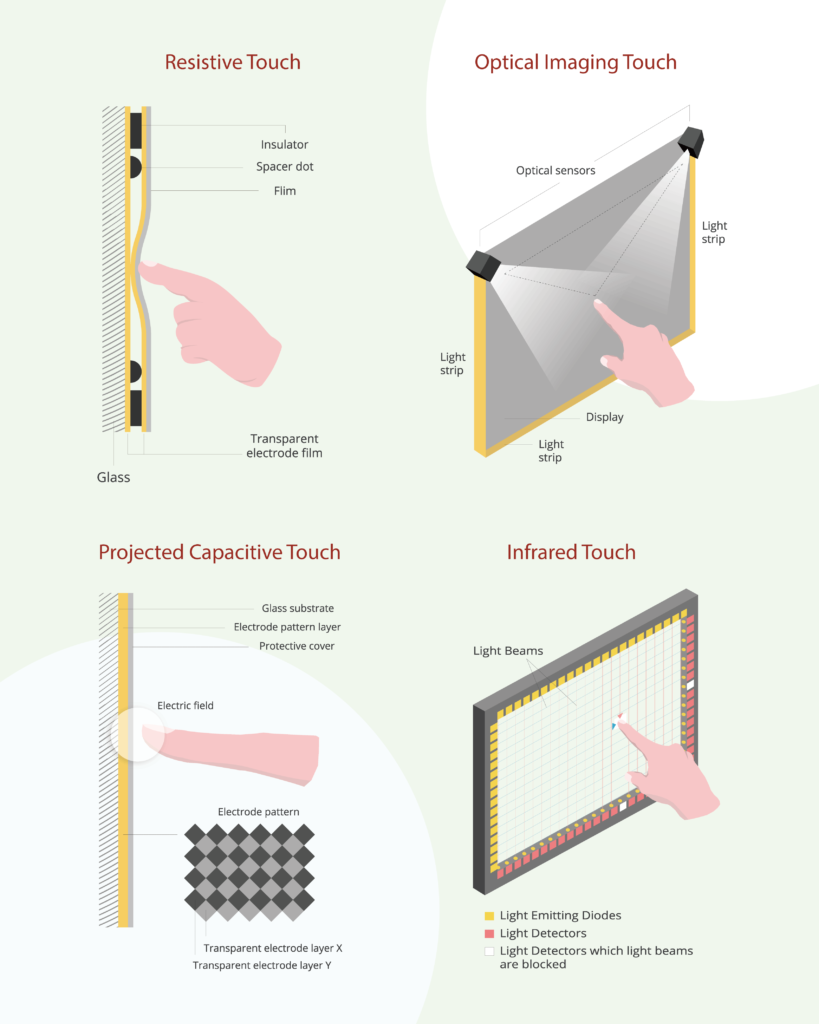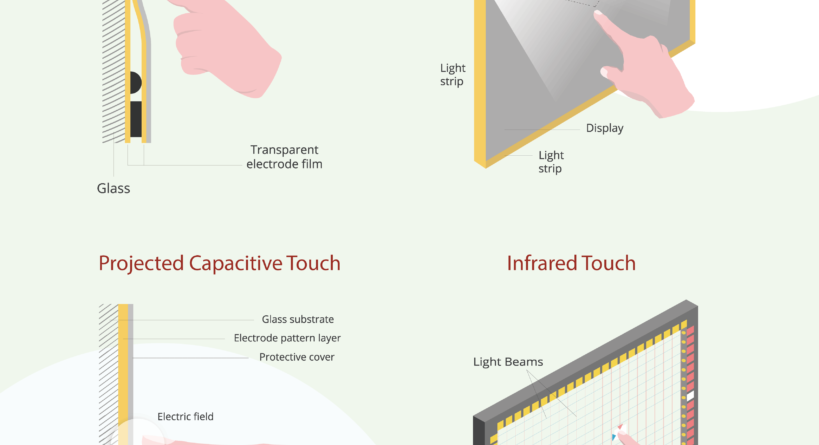What Are Touch Panels?
Touch panels also called touchscreens or touch monitors are special tools that allow humans to operate computers through fingers or other ways of touch. Moreover, through the use of internal sensors, a user’s touch will be detected, then translated into an instructional command that parlays into visible function.
The Different Touch Panel Types
Studying deeper into the technical side of things, touch panels are not just as cut-and-dry form as they may seem. In fact, the way they sense and react to touch can be widely different based on their different inherent designs. There are 4 touch panel types in regular daily use – Resistive, Infrared, Projected Capacitive, and Optical Imaging. In the next step, we’ll discuss their specifics, which include their merits, demerits, and daily product applications.

1. Infrared Touch
Some like it hot and some don’t. Infrared touch panels definitely fall into the latter category. By setting up a grid of infrared beams across the panel, which may be up to 150-inches, touch is detected by way of this panel’s disruption.
Although infrared touch panels are durable and support multi-touch functionality, it does possess one potential drawback. Depending on where you sit, literally.
Despite infrared implying heat, infrared touch panels actually perform rather poorly in it, particularly in direct sunlight. In those circumstances, the infrared light beams can be disrupted by the sun’s rays, as opposed to your fingers. As such, be sure to place your infrared touch panel device in an appropriately dark location.
2. Resistive Touch
Resistive touch panels are cost-effective variants that detect commands by way of pressure placed on the screen. This pressure sensitivity is generally limited to single-point touch, with a 20-inch maximum screen, which is fine for many usage cases. These range from styluses to fingertips. As a result, if used correctly, resistive touch panels will remain functional even if a water drop has landed on the screen.
As a result of this versatility, however, many will find that resistive touch panels are less durable than their competitors. Moreover, with its reliance on single-point touch, this touch panel type is not actually capable of multi-touch functionality. Regardless, resistive touch panels are often found in grocery stores, where stylus-based signatures are typically required after credit card purchases.
3. Projected Capacitive Touch
If you identify with the phrase, “go with what you know”, then projected capacitive touch panels are the touch panel type for you. For now, you can guess where you know it from.
By way of their electrical-based touch detection, Projected Capacitive touch panels are known for their high precision and high-speed response times. What’s more is that they possess multi-touch functionality and can be used within small, compact, yet expensive, devices. Due to their underlying technology, it has proven challenging to scale up to larger sizes. Figured it out yet?
Assuming you haven’t, or would like to enjoy the gratified feeling associated with being right, allow us to reveal where you interact with projected capacitive touch panels on a daily basis – Smart Phones! What’s more is that they’re not alone, with tablet computers and GPS devices also utilizing projected capacitive touch screens.
4. Optical Imaging Touch
Light, and the disruption thereof, is not just a great way to produce a shadow, but also to design a touch panel type. To take advantage of this principle, optical imaging touch panels are designed to sense touch through infrared cameras and the disruption of light strips. This can be achieved through any input you want, across its 100-inch maximum size, from gloves to bare hands, and beyond.
All in all, optical imaging touch panels are just about the most versatile option the touch-based world can offer. From durability to multi-touch, and universal input prospects, the possibilities may truly be endless. Although its only disadvantage maybe its non-compact design, common applications of optical imaging touch panels include certain varieties of interactive whiteboards.
Touch Panel Types in the Professional World
It would be a mistake to limit all of these touch-panel-type applications to consumer devices, even those mentioned earlier. In fact, these touch panel types can be found in everyday life and various industries.
What’s more, in many of these industries, these touch-panel types are used less to sell products to consumers and more to sell solutions to businesses. Whether in finance, manufacturing, medicine or education, touch-based solutions are needed. Combined with the so-called “Internet of Things”, these touch-based solutions play a key role in industry 4.0-related practices.
During the practice, to a large extent, these solutions provide users with a way to save people and manage them. For example, in a store, hospital, or bank, these touch panel types can answer basic questions, provide product information, or provide directions based on the user’s needs. On the manufacturing side, it is also possible to manage employees in the form of workplace assignments or attendance tracking.
Golden Margins –
Entire Range of Touchscreen Products


We hope you found these touchscreen or panel PC fundamentals informative. Goldenmargins offers a broad selection of Industrial Touchscreen Monitors and Touch Panel PCs in various sizes and configurations, including medical touch screens, sunlight-readable touch screens, open-frame touch screens, and waterproof touch panels, as well as other unique touch screen or panel PC designs. You can learn more about our services HERE or by calling us at +86 755 23191996 or sales@goldenmargins.com





